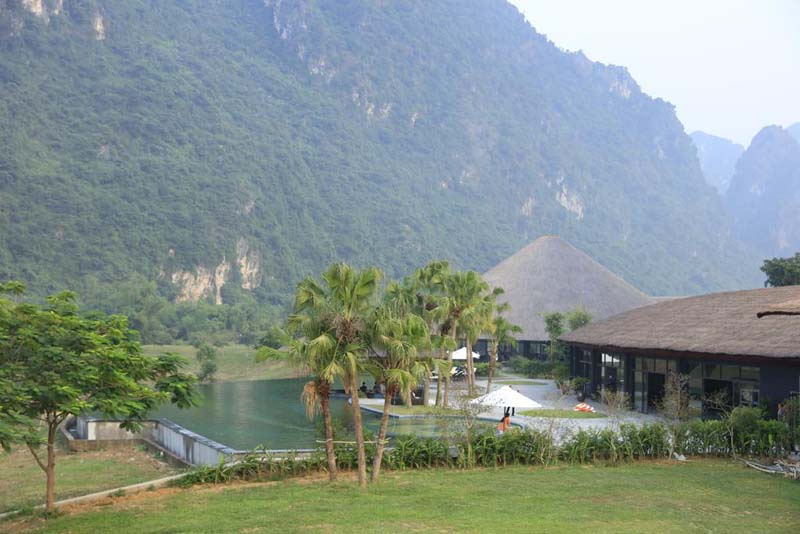
(HBO) - Kim Boi district is home to many beautiful natural landscapes, well-known for folk culture and traditional festivals imbued with Muong ethnic culture. It is endowed with a natural hot spring rated as one of the best mineral water sources in Southeast Asia, a considerable potential and strength to develop tourism. Together with Lac Thuy and Yen Thuy districts, Kim Boi will become a key tourist cluster of the province during the 2014-2020 period with a vision to 2030.
 Serena resort in Sao Bay commune,
a famous tourist destination of Kim Boi district thanks to its beautiful
scenery and hi-end services.
Serena resort in Sao Bay commune,
a famous tourist destination of Kim Boi district thanks to its beautiful
scenery and hi-end services.
A highlight of the district's
tourism is the attraction of investment in building resorts and hot springs. Investors are attentive to such kind of
investment as Serena resort, An Lac resort, Cong Doan hotel, and nursing centre
for veteran revolutionaries. Quite a few visitors are impressed by the beauty
of the nine Tu Son waterfalls like clouds floating in the middle of imposing
mountains, Mat Troi waterfall with wild beauty and clouds all year round; or
Thuong Tien nature reserve with rare and rich flora and fauna, including more
than 80 species of animals and 39 species of plants named in the Red Book of
Vietnam.
It is also a land with a long-standing history, and numerous vestiges
of historical and cultural values. Dong Thech tomb area in Vinh Dong commune
from the late 17th century, with a number of large and small stone
slabs inscribed with Han – Nom scripts, has been recognised as a national
archaeological site.
Apart from hot spring bath, managers
of tourism areas pay special attention to culinary culture with signature
dishes such as Muong Dong bamboo rice, sticky rice, chicken stewed with sour
bamboo shoots, buffalo meat, sour fish, and others that have created an
unforgettable aftertaste in the hearts of visitors. Last year, the district
welcomed over 262,000 tourists, raking in over 175 billion VND.
In order to achieve the goal
of developing high-quality tourism with high-class resorts in combination with community
tourism, the district Party Committee, People's Council and People's Committee directed
further popularising images of local tourism, calling for tourism investment, investing
in technical infrastructure and lodging facilities, and attracting private
investment while developing lodging facilities, restaurants and entertainment
areas. The district strives to welcome about 400,000 visitors and earn about
460 billion VND by 2025, serve around 650,000 tourists and rake in 900 billion
VND by 2030./.
A diverse chain of eco-tourism and resort destinations concentrated in Hoa Binh city and the districts of Tan Lac, Da Bac, and Luong Son… Along with the launch of several key high-quality resort tourism projects, these developments have reshaped the landscape and enhanced the appeal of Hoa Binh as a travel destination.
Boasting diverse terrain, a mild climate, and rich natural resources, Cao Phong district is increasingly asserting its place on Vietnam’s tourism map, attracting both domestic and foreign visitors. The district is renowned for its stunning landscapes, majestic mountains, a crystal-clear hydropower lake, and the unique cultural identity of local ethnic groups.
With its pristine landscapes, unique cultural heritage of Muong ethnic minority, and an expanding range of visitor experiences, Tan Lac district of Hoa Binh has fast become a captivating destination for both domestic and international tourists.
Until now, Sung village in Cao Son commune, Da Bac district remains the only Dao ethnic community in Hoa Binh province to develop a community-based tourism model. Beyond its untouched natural landscapes, cultural identity serves as the cornerstone attraction for visitors.
Alongside the diverse cultural identities of the Kinh, Muong, Tay, Thai, Dao, and Mong ethnic people, Hoa Binh province is also renowned as the "capital" of the northwestern Vietnamese cuisine, offering unique and distinctive dishes. At festivals, during Lunar New Year (Tet), or on significant family or community occasions, special dishes are prepared, leaving a lasting impression on visitors.
A Phong Linh (Yellow Tabebuia) flower garden in Thang village, Thach Yen commune, Cao Phong district is currently in full bloom, drawing a large number of visitors.



 Serena resort in Sao Bay commune,
a famous tourist destination of Kim Boi district thanks to its beautiful
scenery and hi-end services.
Serena resort in Sao Bay commune,
a famous tourist destination of Kim Boi district thanks to its beautiful
scenery and hi-end services.